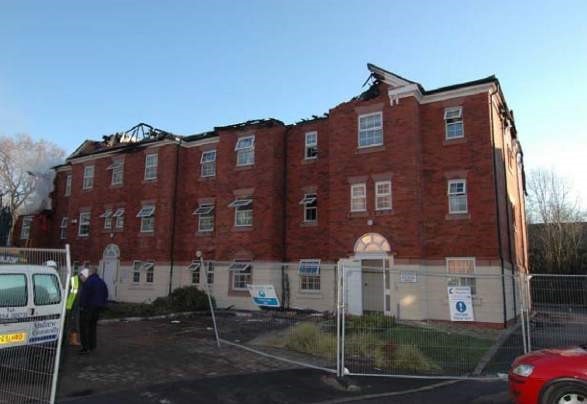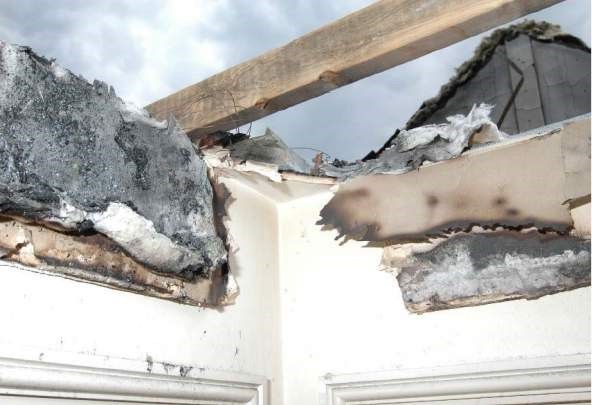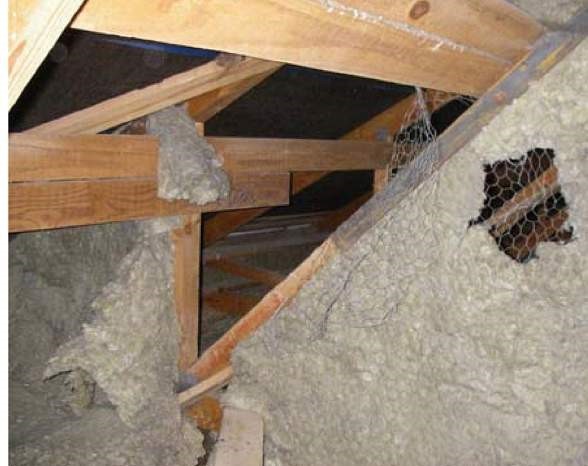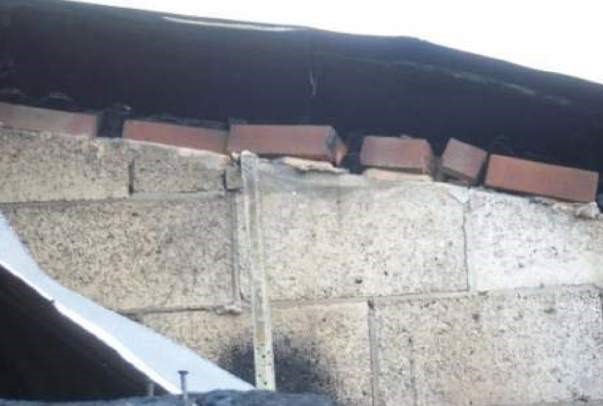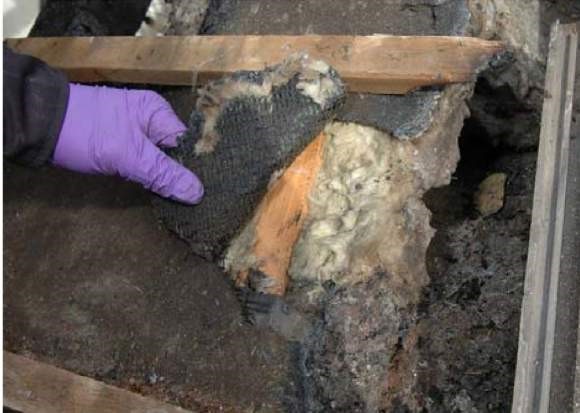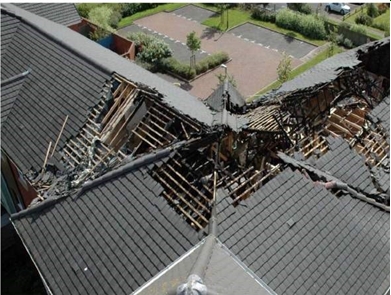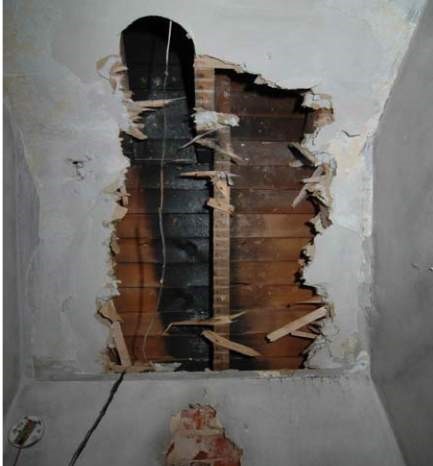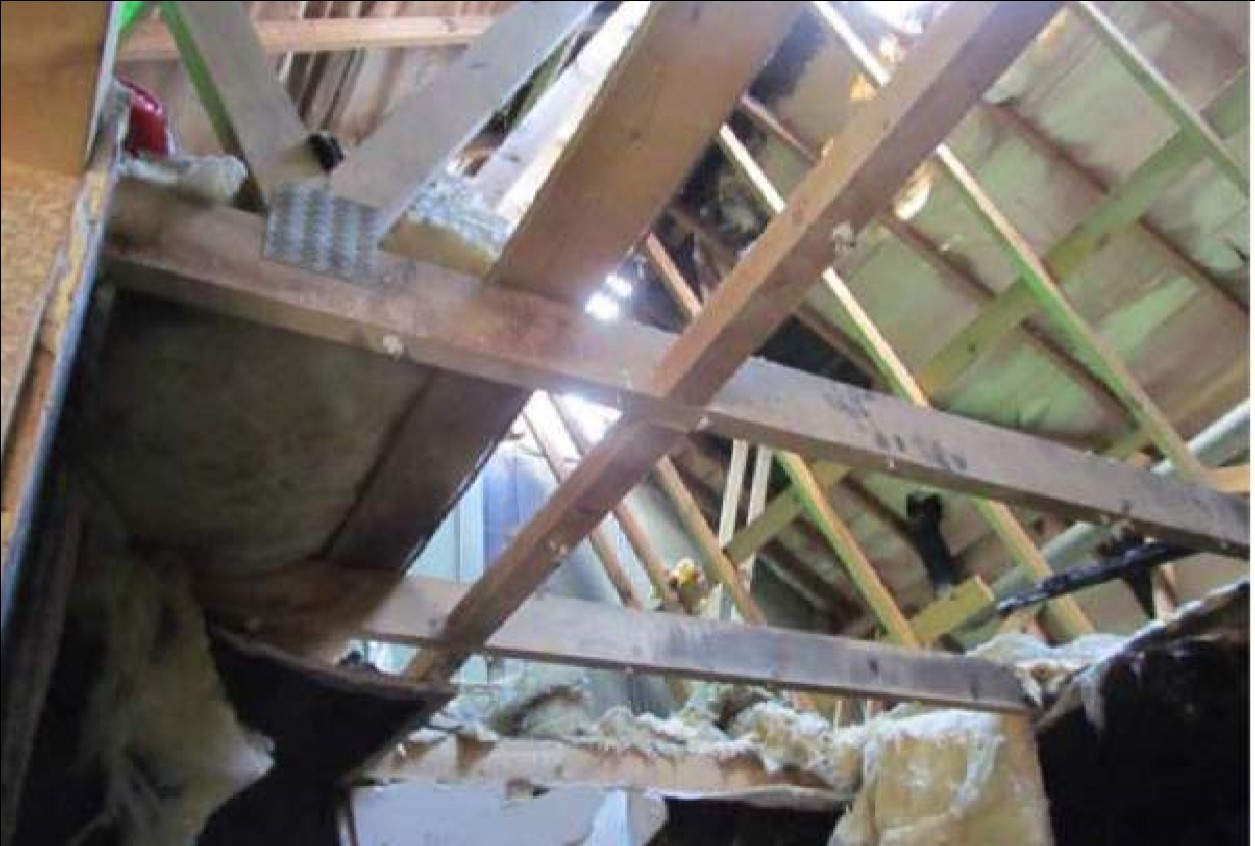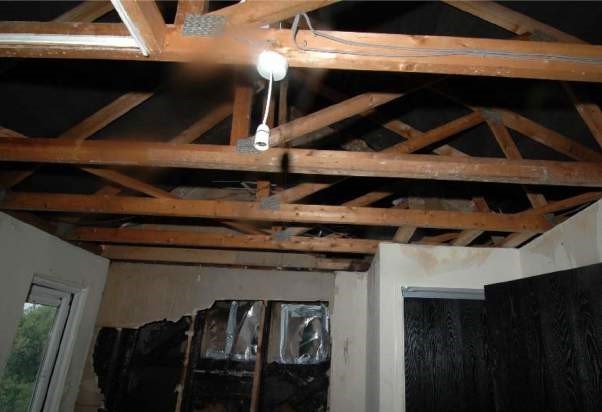Designing out fire risk in roof voids

|
| Fire in concealed spaces such as roof voids can be a killer. This article examines how to reduce the risk at the design stage and during construction. |
[edit] Introduction
BRE Global carries out fire investigation activities on behalf of the Department for Communities and Local Government (DCLG). An important element of its work is to publicise findings to designers.
Fire and smoke-spread in concealed spaces within buildings can present both a life risk to occupants and firefighters, and cause widespread damage with extensive, difficult, and expensive clean-up and re-instatement. Indeed, in some cases, smoke deposits (and their resulting odour) can never be properly removed and buildings have had to be demolished. One such concealed space is the roof void. This article provides an introduction to the issue of concealed fire spread within roof voids considering the ‘lessons learned’ from real fires and the results of poor compartmentation.
In 2010, DCLG (then CLG) published a research study on fire compartmentation in the roof voids of residential buildings [1]. This found it is common practice within the industry for limited details to be included within building regulations applications. This puts the onus on the building contractor to ensure the correct detailing - which increases the risk of errors and omissions.
[edit] Review of actual fires from 2003 to 2013
BRE Global has carried out a review of fires reported to DCLG between 2003 to 2013. Over this period BRE Global has carried out approximately 106 fire investigations either by attendance at the scene or through contact with fire and rescue services; of these fires, 34 had an aspect relevant to concealed fire spread, as follows:
- Eleven fires were solely related to compartmentation in roof voids.
- Ten fires were solely related to issues with cavity barriers.
- Six of the 34 fires combined issues with compartmentation in roof voids and cavity barriers.
- Four fires were related to fires in/issues with ducting.
- One fire was related to ducting and compartmentation in roof voids.
- One fire was related to ducting and cavity barriers.
The main issues of note were:
- There were seven cases where the junctions of the compartment wall with the roof were either not fire stopped or the fire stopping was inadequate and not continued to the roof.
- There were three cases where compartmentation in roof voids was effective and prevented fire spread throughout the void.
- There were five cases where mineral wool in wire netting was used as a cavity barrier in a roof space but was shown to be inadequate mostly due to holes in the barriers.
- There were three cases where ‘push-fit’ cavity barriers were installed but moved after construction was completed (or were poorly fitted in the first place).
- Twenty of the 34 cases involved inadequate cavity barriers; this includes absence of cavity barriers and poorly fitted cavity barriers.
- There were two cases where ducts passing through compartment walls were not fire stopped.
It is evident that compartmentation in roof voids is a particular issue with respect to hidden fire spread but that adequate compartmentation and correctly specified cavity barriers can be effective in limiting fire damage.
[edit] Issues from specific fire investigations involving fire spread in roof voids
The BRE Global fire investigation database has been reviewed to identify those areas where compartmentation in roof voids played a role (either positively or negatively) in fire development and the nature and extent of fire spread. Ten case studies have been chosen by BRE Global and are reported here due to their relevance to compartmentation in roof voids. To ensure confidentiality, no mention is made here of specific locations and all incidents are referred to with reference to the type of structure involved.
[edit] Case study 1: Residential development (four and five-storey apartment blocks)
The fire started in a small section of a flat roof of one apartment block, ignited the sarking felt on the adjacent pitched roof and spread into the roof void. The fire spread within the roof space over three apartments, bypassing two compartment walls.
Eventually, the fire spread into the roof void of an adjacent block, again involving three apartments and bypassing two compartment walls. The compartment walls were constructed from concrete building blocks. However, it was clear from the scene that no attempt had been made to fire-stop the junction between the walls and the roof as detailed in Approved Document B [2]. Figure 1 shows the junction of the compartment wall with the roof covering.
Fig. 1 Lack of fire-stopping between compartment wall and roof covering.
[edit] Case study 2: Three-storey block of flats
It is likely that the fire was initiated as a result of hot work being carried out on pipes penetrating the exterior wall of the three-storey block of flats. Initial fire spread was through the external wall cavity breaking out at roof level some distance from the point of origin. Once in the roof area, the fire spread rapidly, leading to collapse of the roof trusses and break out back into the floors below. It is clear from the speed and extent of the fire spread that the cavity barriers in the wall and compartmentation within the roof space were ineffective. Figure 2 shows the point of fire origin and the area where the fire broke out from the roof.
Fig. 2. Block of flats showing the area of fire origin and damage to roof level.
[edit] Case study 3: Four-storey residential building
The fire is believed to have started on the landing of the second floor of a four-storey residential building. The fire spread from here to involve the third (top) floor landing and ultimately, to the roof structure, most probably via the roof soffit above a window onto the landing. Compartmentation was breached as the fire traversed the roof structure over a number of compartment walls. The compartment walls were constructed from concrete blocks clad in plasterboard with a plaster skim coat. The walls were continued up through the ceiling to the underside of the roof covering. The seal between the top of the wall and the roof covering seems to have been made from mineral wool (see Figure 3).
Fig. 3 Mineral wool fire stopping along pitch of roof in the background of the photograph
It is believed that the fire spread due to a combustible membrane between the tiles and the roof structure.
[edit] Case study 4: Four-storey apartment block
Fire broke out in one of the flats on the top floor of a four-storey apartment block. The fire broke out of the window and into the roof void through the roof eaves soffit and spread to destroy the entire roof area. The roof was a new pitched roof over an existing flat roof formed from a concrete slab. For this reason, the roof void could be considered to be a single compartment and separation would be necessary to maintain the maximum distances of cavities rather than specifically to maintain compartmentation.
Separation was provided in the roof space at approximately 15m intervals, comprising mineral wool and chicken wire curtains held in place with metal bars fixed to the timber trusses. The separation in the roof space clearly did not perform as intended. The poor state of the compartmentation in the roof space had been highlighted in a previous report following a fire on the same estate. The condition of the fire stopping in the roof space in a similar block is illustrated in Figure 4.
Fig. 4 Fire stopping in poor condition (image courtesy of London Fire Brigade)
[edit] Case study 5 – Three-storey block of flats
The fire occurred in a flat on the top floor of a three-storey block of flats and spread into the roof space. The fire developed to involve the roof space over all three flats on the top floor. Fire spread over the compartment walls in the roof area appears to have been due to a combination of poor fire stopping in the compartment walls above ceiling level, poor fire stopping where the curved sections of the roof crossed the compartment walls, and fire bridging the compartment walls due to the presence of combustible materials within the makeup of the roof covering.
Figure 5 shows the attempt made to provide fire stopping where the curved section of the roof crossed the compartment wall.
Fig. 5 Attempt to provide fire stopping in curved section of wall.
[edit] Case study 6: Two- and three-storey blocks of flats
The fire started in a first-floor flat of a block of flats, broke out of the room of origin through a window, and entered the roof through the eaves. Fire spread rapidly throughout the structure of the roof. The roof was constructed from lightweight timber truss rafters while the roof covering was ceramic tiles under which a bitumen impregnated sarking felt had been fixed. Fire separation within the roof space was completed using a mixture of blockwork and cavity barriers.
The cavity barriers were constructed from mineral wool fixed to a wire mesh. The barriers were fixed to timber trusses using clamping plates. The fixing of the fire barrier to the timber trusses does not appear to have been in accordance with manufacturer’s guidance since the barriers did not press up against the underside of the sarking felt so the fire was able to spread along the sarking felt over the top of the cavity barriers (see Figure 6).
Fig. 6 Fire stopping against underside of sarking felt but not pushed up against underside of roof tiles.
[edit] Case study 7: Three-storey block of flats
The fire is believed to have been started by a cigarette discarded in wood chippings in flower beds arranged around the outside of a three-storey block of flats and in contact with the external wall. The fire spread from the wood chippings into the cavity of the external wall via a plastic air brick situated beneath the suspended ground floor and providing ventilation to the cavity .
Cavity barriers in the external wall cavity were either missing or poorly fitted. The fire spread up the cavity to the roof of the building, causing significant structural damage to the roof and accommodation storeys. A combination of fire-fighting and effective compartmentation, both between compartments and within the roof space, prevented more extensive fire spread within the building. Figure 7 is an aerial view of the building showing the damage at roof level.
Fig. 7 Aerial view showing damage to roof structure.
[edit] Case study 8: Two-storey residential care home
Fire started within a first-floor bedroom of a two-storey residential care home. Smoke entered a wall cavity and found its way into the roof void where a detector was activated. Due to early activation and the prompt action of the fire and rescue service, the fire was prevented from spreading into the roof void. However, there was inadequate separation within the roof space. The junction between the external wall cavity and the roof space is shown in Figure 8.
Fig. 8 Close up of fire damage to pitch roof.
[edit] Case study 9: Three-storey timber-frame terraced house
The fire was started within an upper-floor bedroom of a three-storey timber frame terraced house; flames spread into an external wall cavity through failure of a uPVC window frame. From there, it spread into a compartment wall separating dwellings.
In this case, the quality of the compartmentation in the roof space prevented more widespread damage as can be seen from the undamaged roof trusses in Figure 9. The compartmentation was formed from two layers of plasterboard either side of the timber frame compartment wall, with all joints fully taped and sealed.
Fig. 9 Undamaged roof trusses above seat of fire.
[edit] Case study 10: Mixed residential timber-frame development
The fire started within a ground-floor flat and spread via the external façade into the compartment wall between occupancies. As with the incident in Case 9, the quality of compartmentation in the roof space, as shown in Figure 10, restricted the amount of damage from the fire.
Fig. 10. Top floor of property showing fire damage to party wall but roof trusses are unaffected by the fire due to compartmentation.
[edit] Further work on compartmentation in roof voids
DCLG commissioned BRE Global to carry out a research project titled ‘Compartment sizes, resistance to fire and fire safety’. As part of this project, BRE Global undertook a series of full-scale fire experiments within a purpose-built fire compartment within the BRE Burn Hall. The experimental programme encompassed fully-developed post-flashover fires, focused on investigating the influence of high levels of thermal insulation on fire growth, development and space separation between buildings, and fires within an enclosure representative of a basement fire with limited ventilation provided via horizontal openings in the ceiling.
The final experiment in the series used the fire compartment to provide a room on which a trussed rafter roof was constructed incorporating a compartment wall typical of a standard spandrel panel detail used in timber frame construction. The findings from this research programme have been published at http://www.bre.co.uk
[edit] Conclusions
The fire protection of concealed spaces is of prime importance because any deficiencies in the installation and materials are not readily apparent and may quickly be covered over. Any inadequacies in such fire protection cannot be observed by the building users and, unlike other engineering provisions within the building, will not be directly apparent by its impact on every-day life. Any inadequacies in the fire protection of concealed spaces will only become apparent during the very time that their effectiveness is required – during a fire. Compartmentation in roof voids is a particular issue with respect to hidden fire spread. The biggest issue remains that of quality of construction. The research presented here and supported by the case studies shows that poor workmanship with inappropriate materials are the main reasons for the inadequate protection of concealed spaces. There is a clear and demonstrable need to ensure that buildings are designed and constructed so that the unseen spread of fire and smoke within concealed spaces within its structure and fabric is inhibited, as required by the Building Regulations. There is adequate guidance available in the public domain to allow this to be achieved. See existing guidance on fire compartmentation in roof voids
It also follows that the fire safety information required under Regulation 38 [9] is essential to those carrying out a fire-risk assessment (under the Fire Safety Order) [10], so that the presence of concealed spaces can be identified and the fire protection they have been afforded can be assessed.
[edit] Acknowledgements
The research on which this article is based was commissioned by the Department for Communities and Local Government (DCLG) and carried out by BRE. Any views expressed are not necessarily those of DCLG, with whose permission the article is published.
Martin Shipp is Technical Development Director, Fire Safety, Ciara Holland is a Fire Investigator. David Crowder is Business Group Manager for Fire Investigation. Tom Lennon is a Principal Consultant, Fire Safety. (All are BRE).
--CIAT
[edit] About this article
This article was written by Martin Shipp, Ciara Holland, David Crowder and Tom Lennon, Building Research Establishment (BRE) Global. It originally appeared as 'Fire in the hole. Designing out fire risk in roof voids' in the Spring 2016 edition of AT Magazine, published by the Chartered Institute of Architectural Technologists (CIAT)
[edit] Related articles on Designing Buildings Wiki
- Existing guidance on fire compartmentation in roof voids.
- Fire and rescue service.
- Fire compartment.
- Fire damper.
- Fire detection and alarm systems.
- Fire resistance.
- Fire safety design.
- Fire-stopping.
- Joint fire code.
[edit] External references
- [1] Communities and Local Government (CLG). Compartmentation in roof voids (BD 2846), Queen’s Printer and Controller of Her Majesty’s Stationery Office, 2010.
- [2] HM Government. The Building Regulations 2010. Fire safety. Approved Document B Volume 2 – Buildings other than dwellinghouses. London. DCLG, 2006 edition incorporating 2007, 2010 and 2013 amendments, Crown Copyright 2006.
- [3] NHBC Design Standards Part 7 Roofs – Chapter 7.2 Pitched roofs, NHBC, Milton Keynes, Effective from 1 January 2012.
- [4] Association for Specialist Fire Protection (ASFP), Ensuring Best Practice for passive fire protection in buildings, Published by BRE Watford.
- [5] Building Research Establishment, BRE Housing Defects Prevention Unit, Defect Action Sheet (Design) 7, Pitched roofs: boxed eaves – preventing fire spread between dwellings, Crown Copyright 1982.
- [6] Building Research Establishment, BRE Housing Defects Prevention Unit, Defect Action Sheet (Design) 8, Pitched roofs: separating wall/roof junction - preventing fire spread between dwellings, Crown Copyright 1982.
- [7] Building Research Establishment Digest 214, Cavity barriers and fire stops: Part 1, Department of the Environment, HMSO, June 1978.
- [8] Building Research Establishment Digest 215, Cavity barriers and fire stops: Part 2, Department of the Environment, HMSO, July 1978.
- [9] Regulation 38 Fire safety information. The Building Regulations 2010. No. 2214 PART 8.
- [10] The Regulatory Reform (Fire Safety) Order 2005, SI 2005 No. 1541.
Featured articles and news
RTPI leader to become new CIOB Chief Executive Officer
Dr Victoria Hills MRTPI, FICE to take over after Caroline Gumble’s departure.
Social and affordable housing, a long term plan for delivery
The “Delivering a Decade of Renewal for Social and Affordable Housing” strategy sets out future path.
A change to adoptive architecture
Effects of global weather warming on architectural detailing, material choice and human interaction.
The proposed publicly owned and backed subsidiary of Homes England, to facilitate new homes.
How big is the problem and what can we do to mitigate the effects?
Overheating guidance and tools for building designers
A number of cool guides to help with the heat.
The UK's Modern Industrial Strategy: A 10 year plan
Previous consultation criticism, current key elements and general support with some persisting reservations.
Building Safety Regulator reforms
New roles, new staff and a new fast track service pave the way for a single construction regulator.
Architectural Technologist CPDs and Communications
CIAT CPD… and how you can do it!
Cooling centres and cool spaces
Managing extreme heat in cities by directing the public to places for heat stress relief and water sources.
Winter gardens: A brief history and warm variations
Extending the season with glass in different forms and terms.
Restoring Great Yarmouth's Winter Gardens
Transforming one of the least sustainable constructions imaginable.
Construction Skills Mission Board launch sector drive
Newly formed government and industry collaboration set strategy for recruiting an additional 100,000 construction workers a year.
New Architects Code comes into effect in September 2025
ARB Architects Code of Conduct and Practice available with ongoing consultation regarding guidance.
Welsh Skills Body (Medr) launches ambitious plan
The new skills body brings together funding and regulation of tertiary education and research for the devolved nation.
Paul Gandy FCIOB announced as next CIOB President
Former Tilbury Douglas CEO takes helm.
UK Infrastructure: A 10 Year Strategy. In brief with reactions
With the National Infrastructure and Service Transformation Authority (NISTA).








